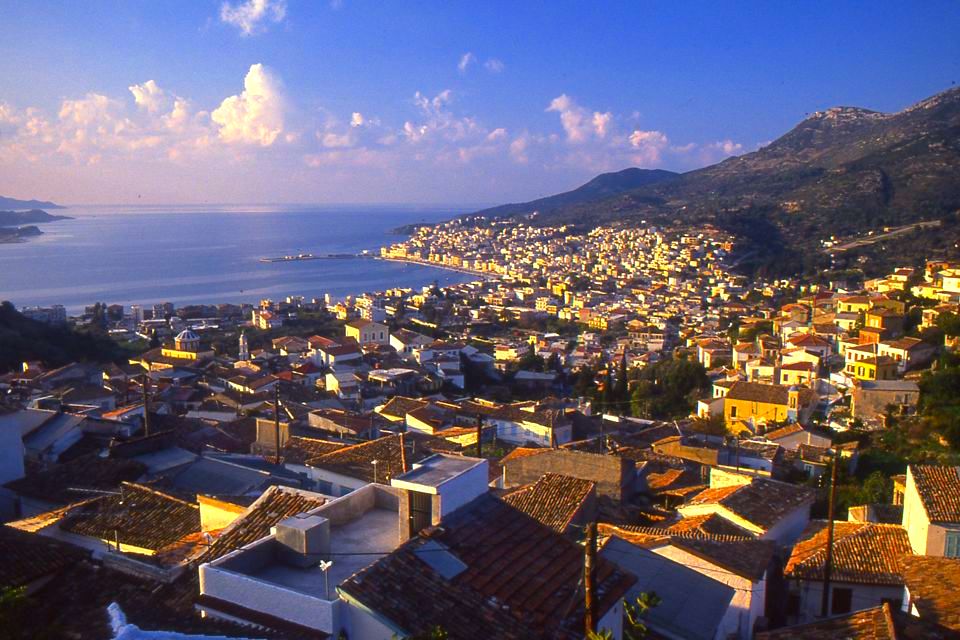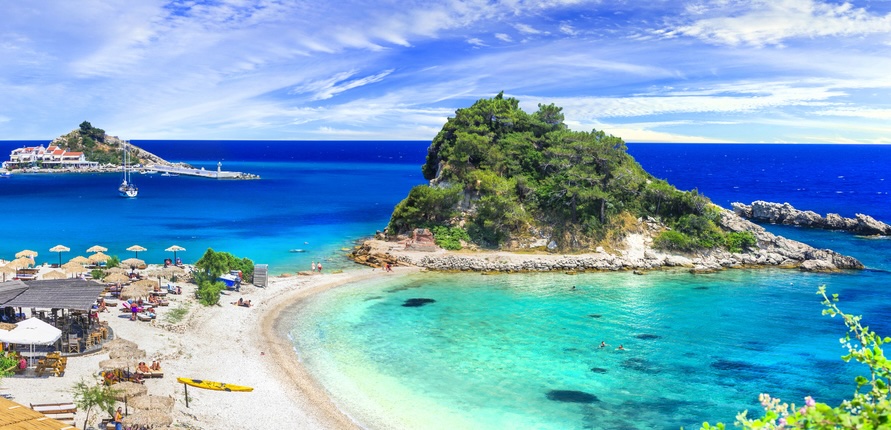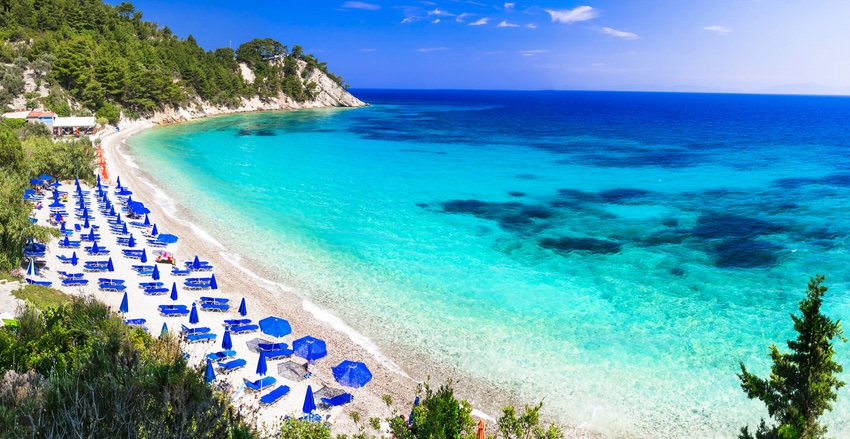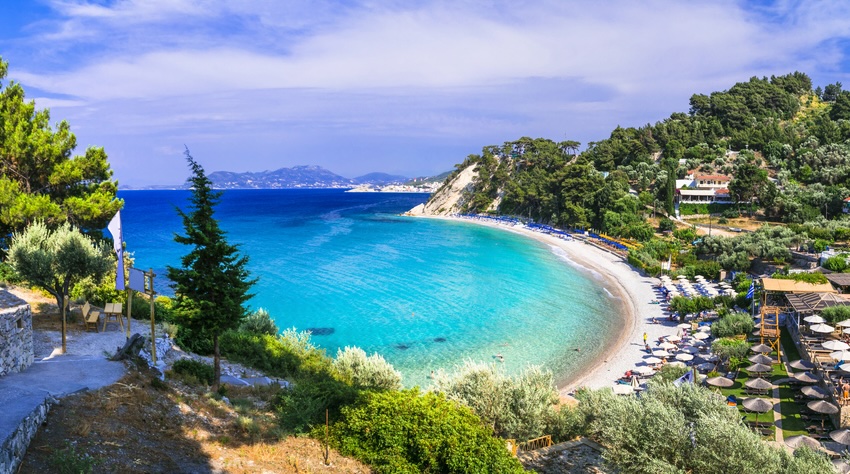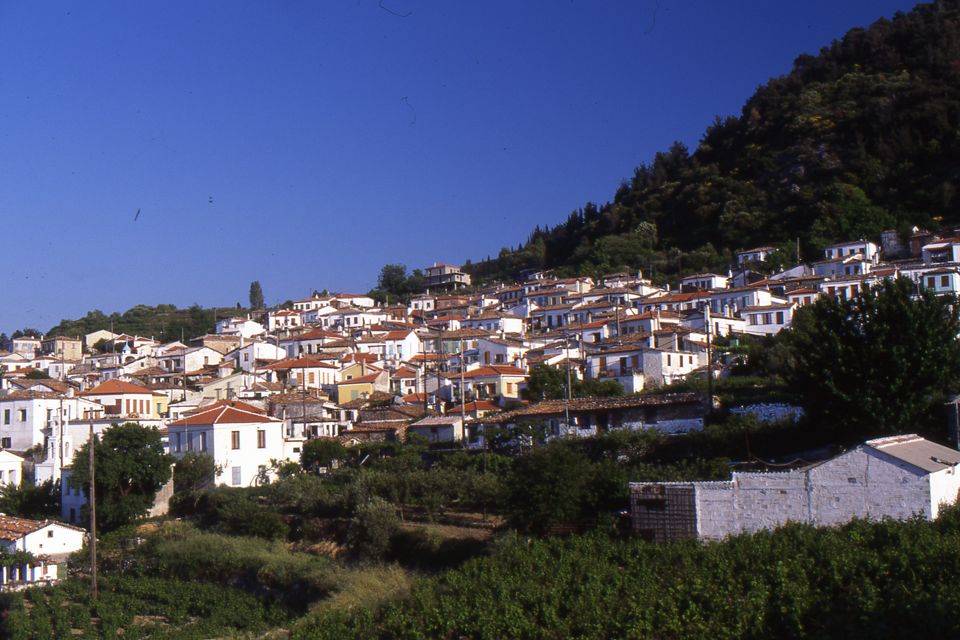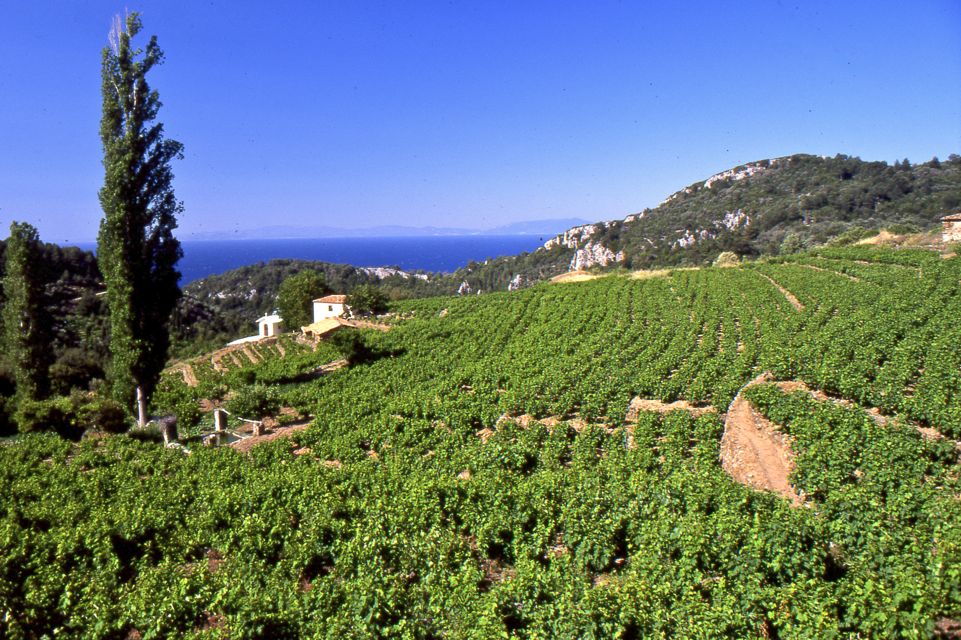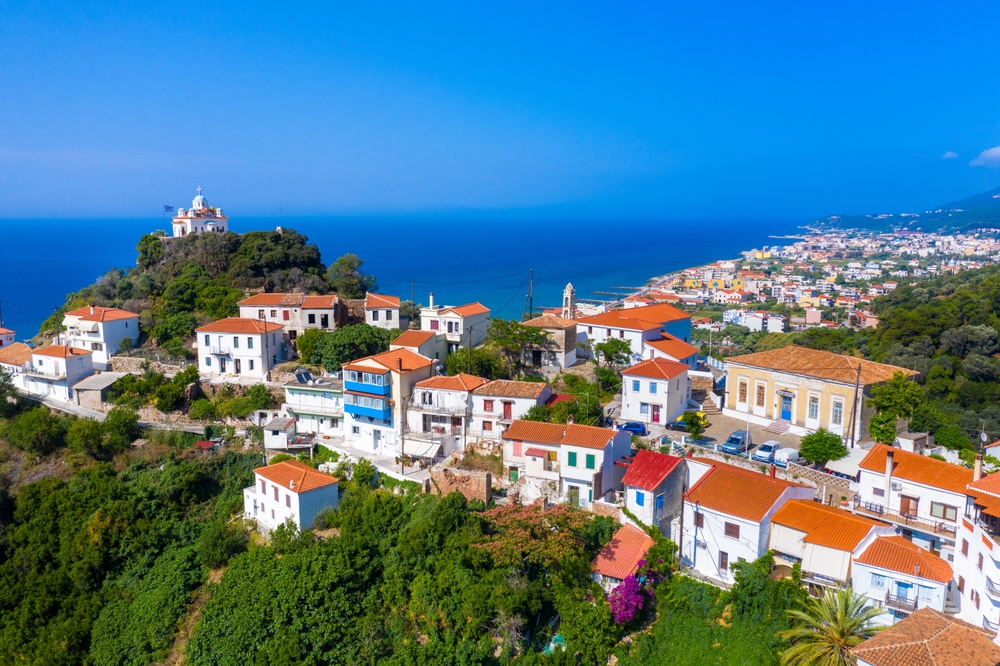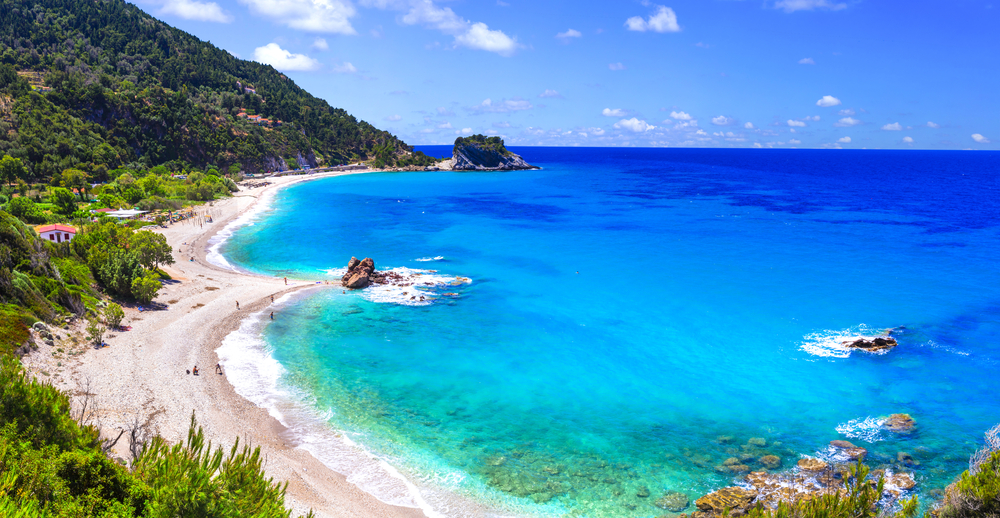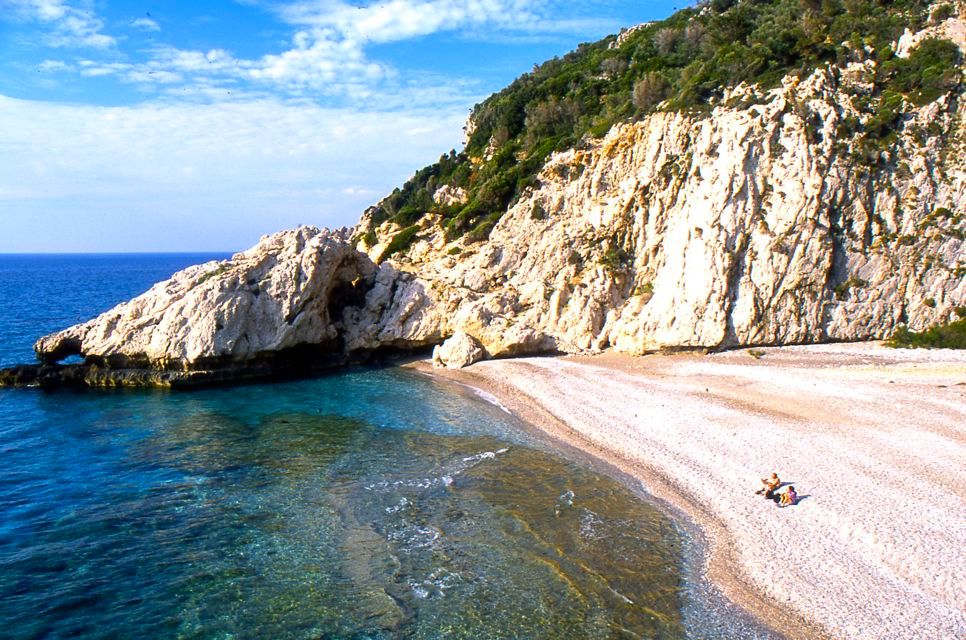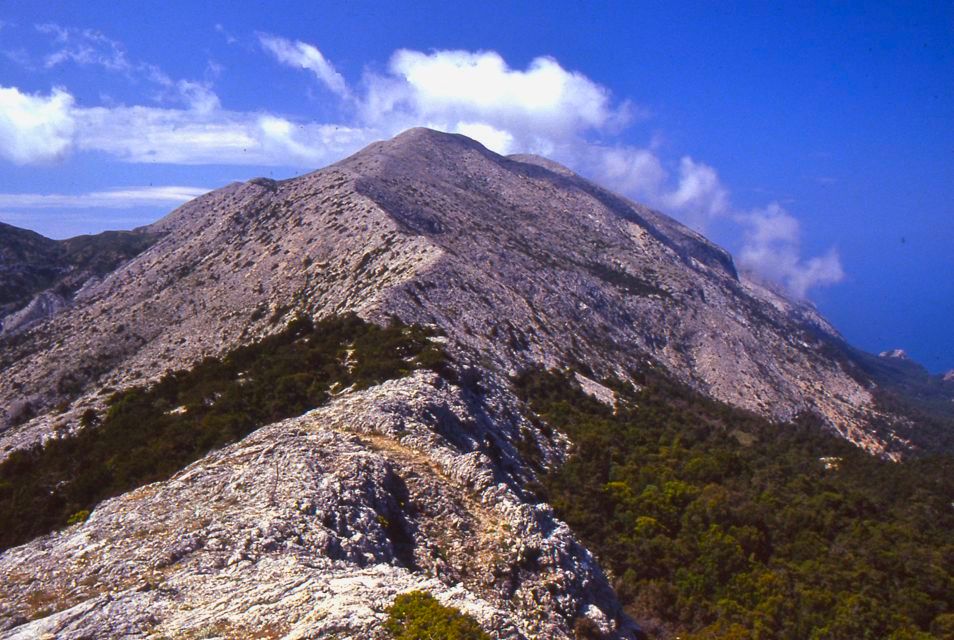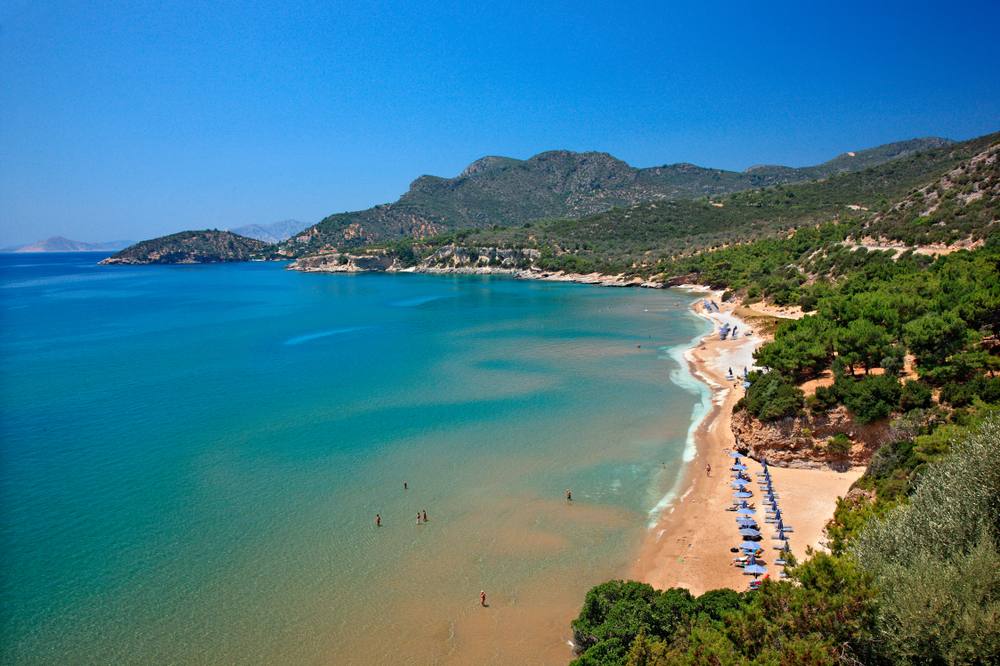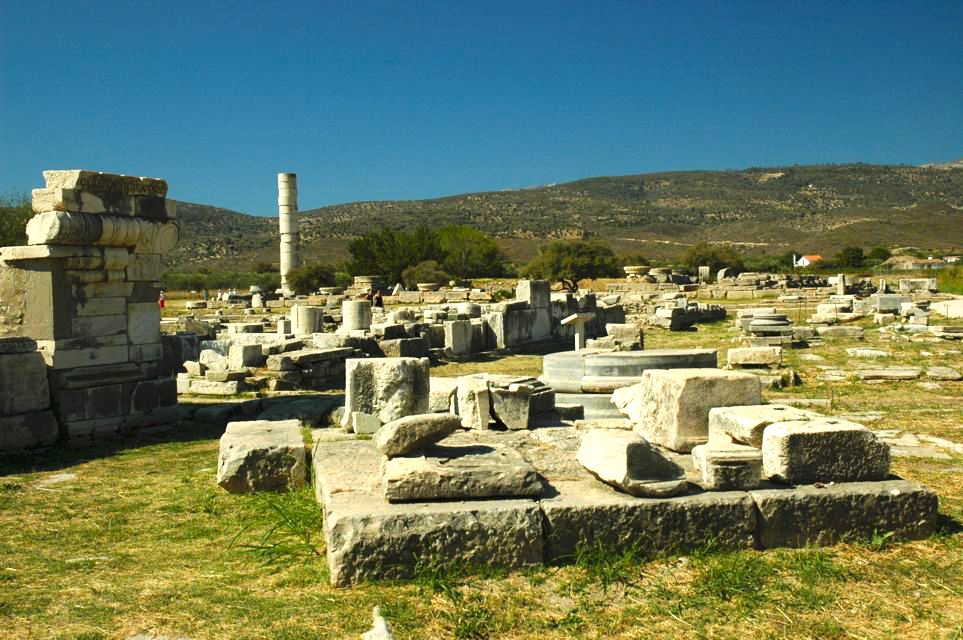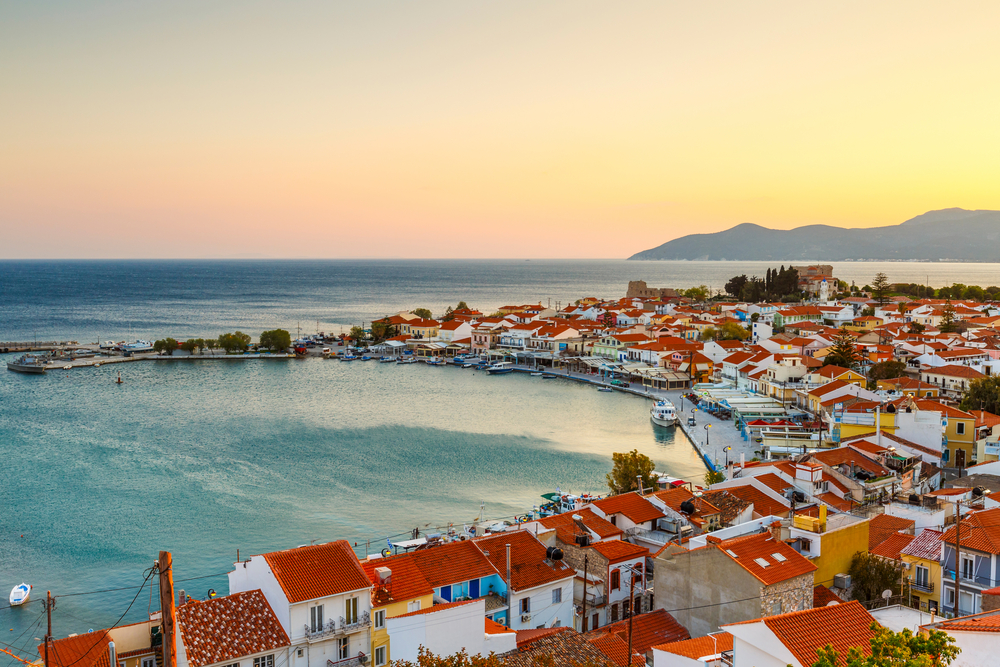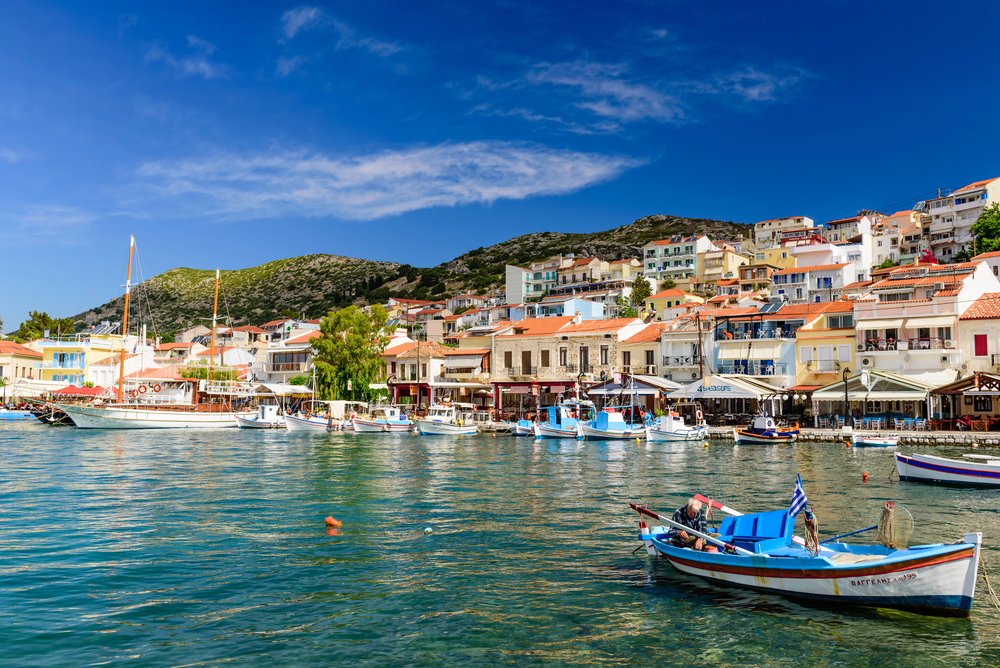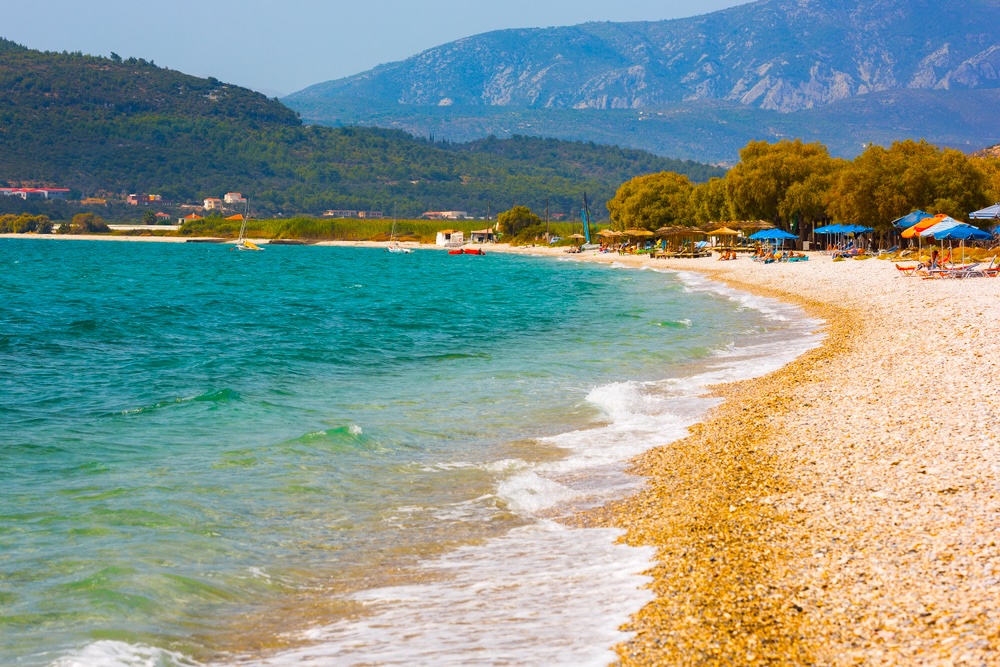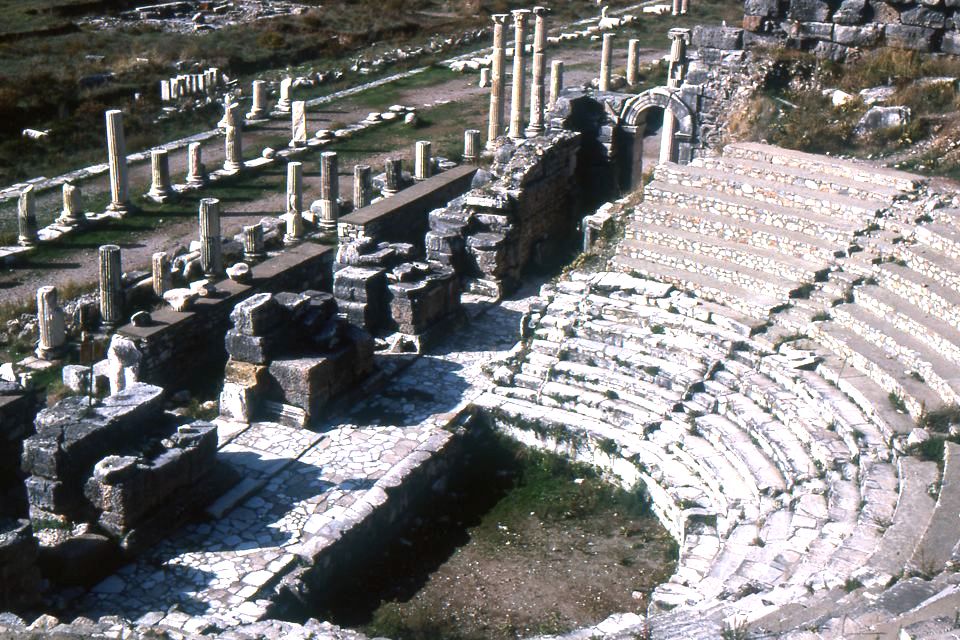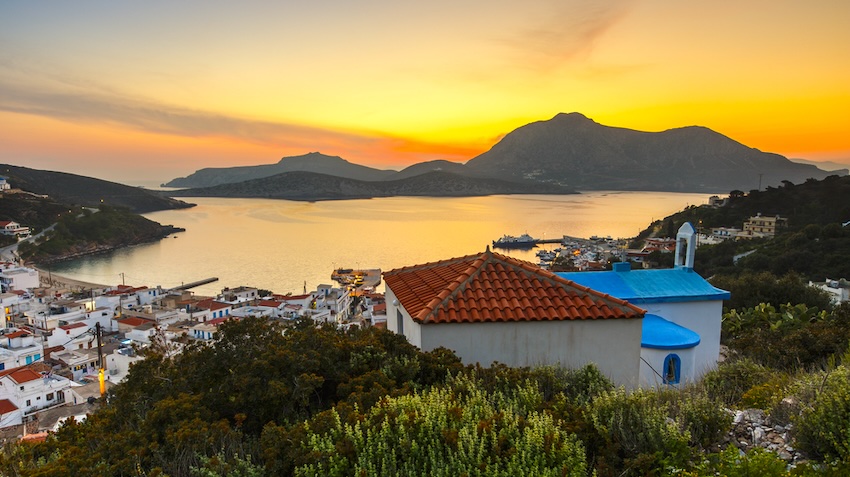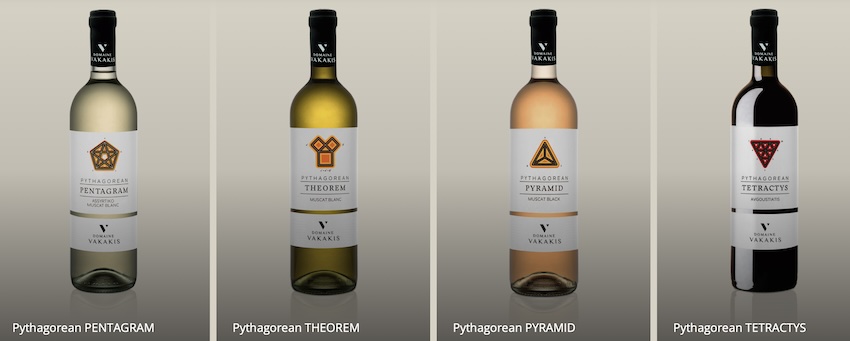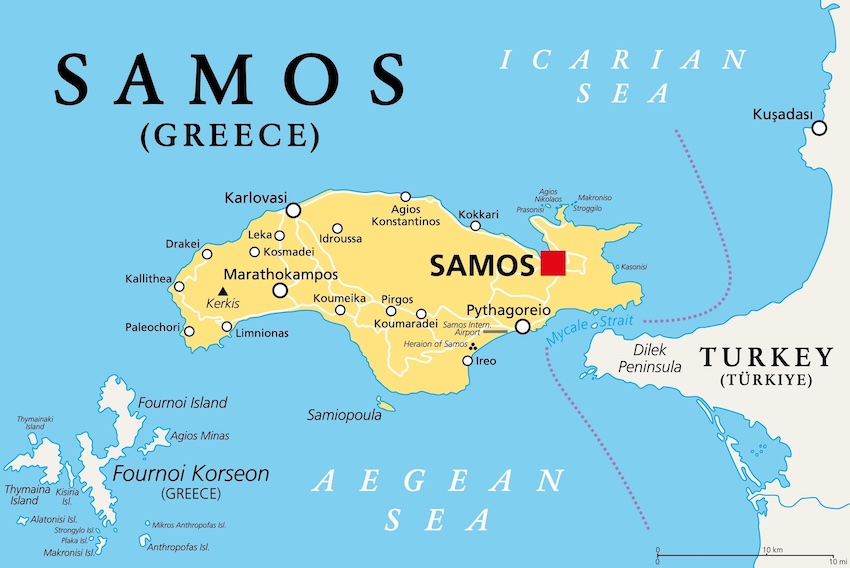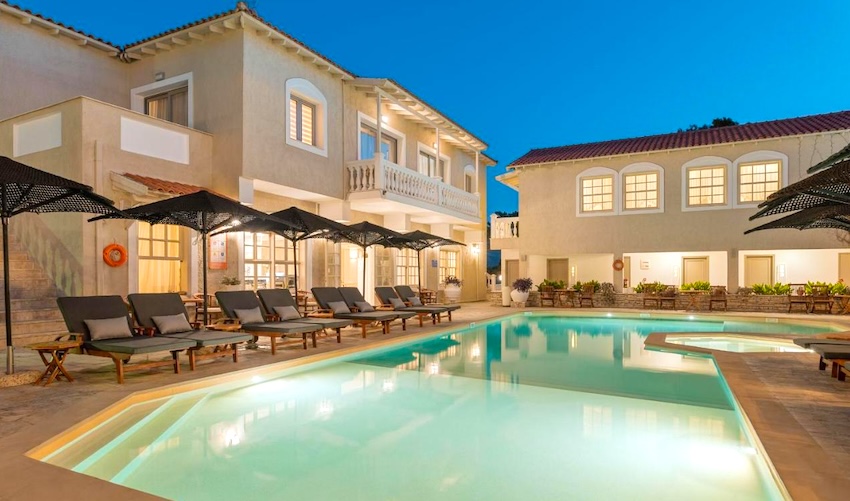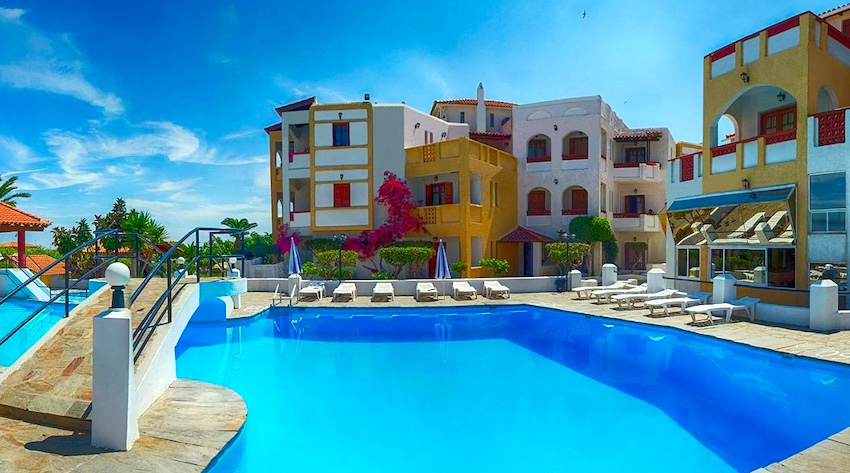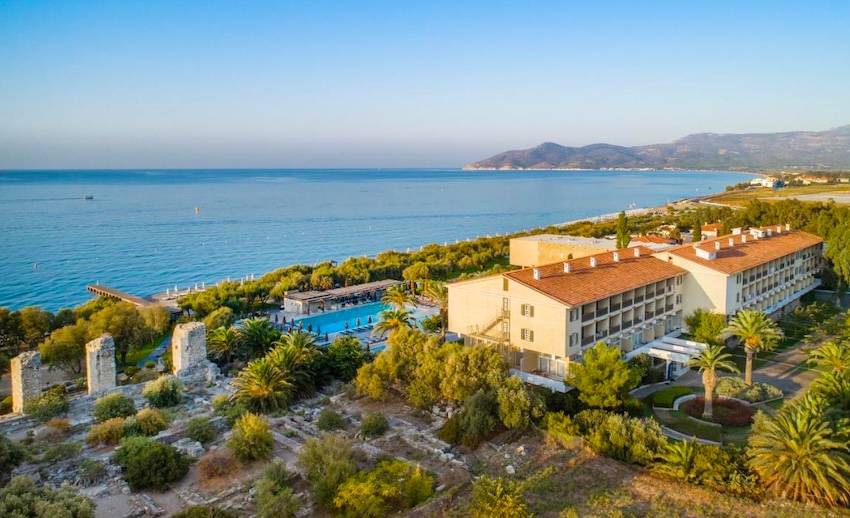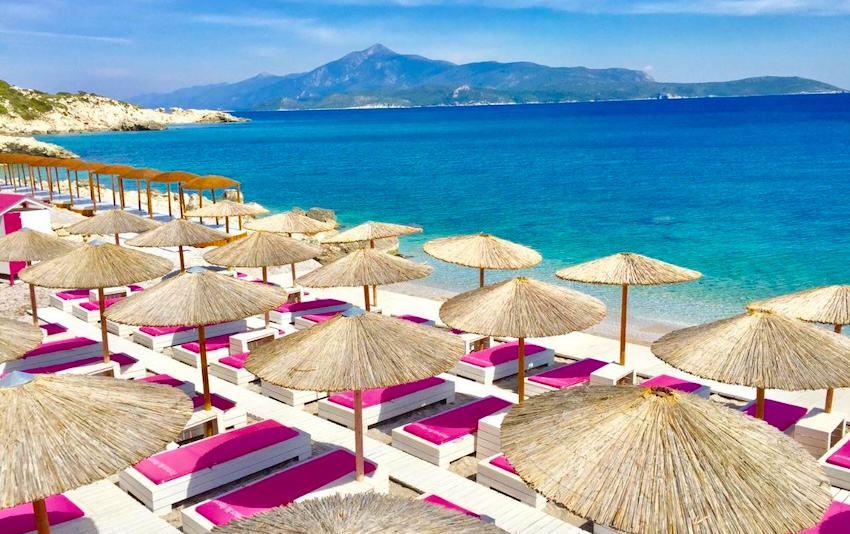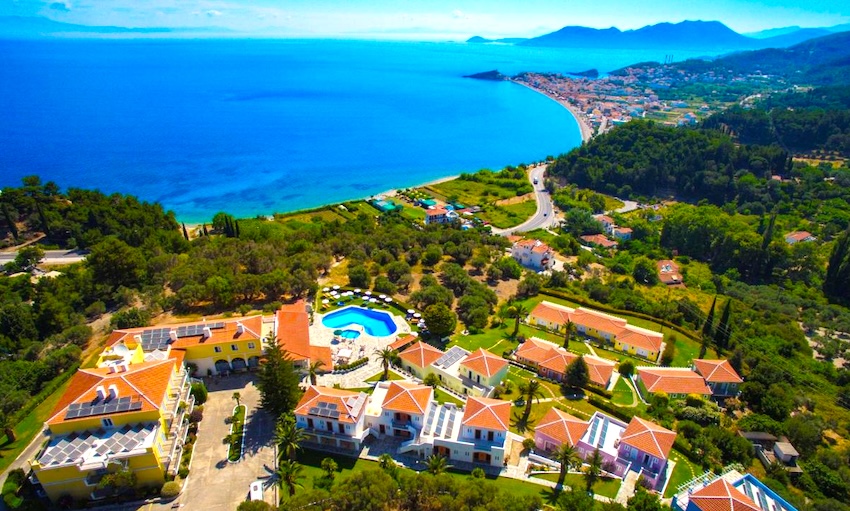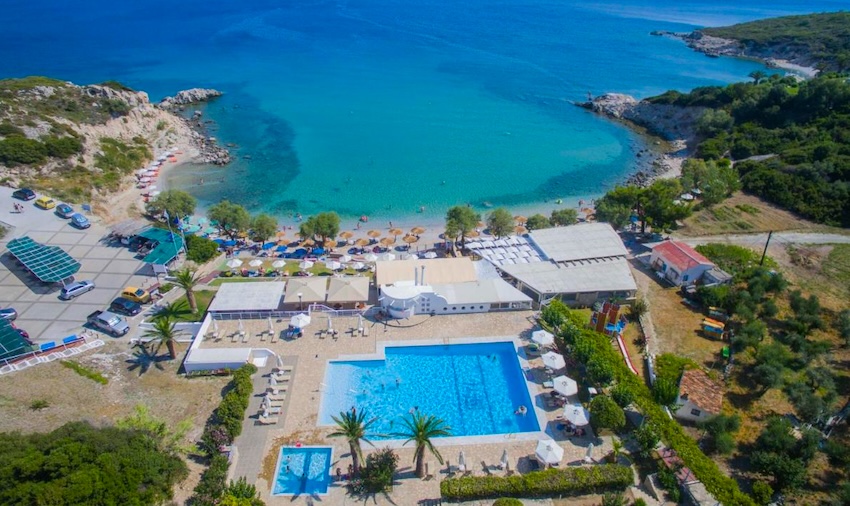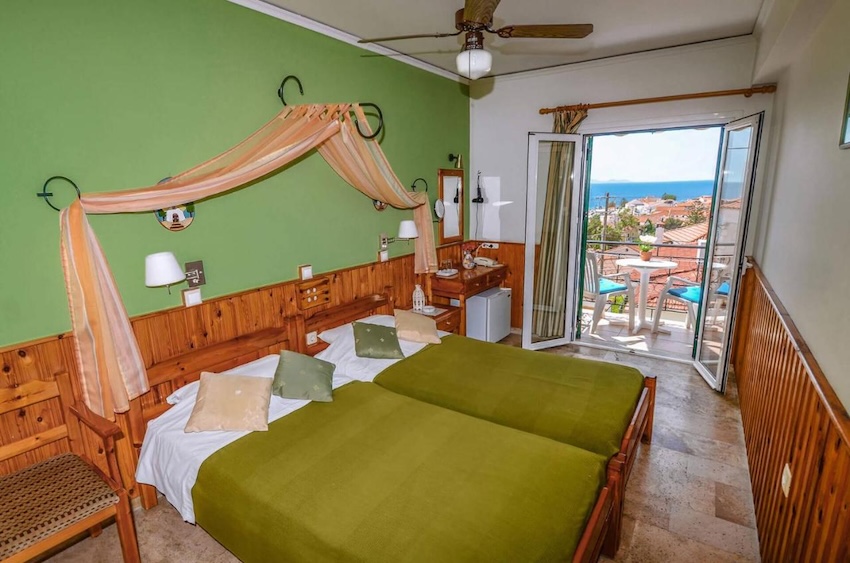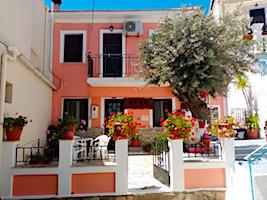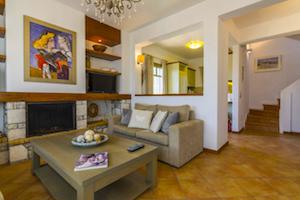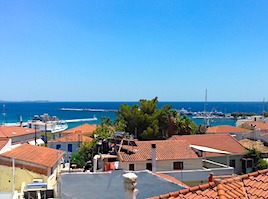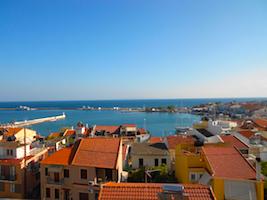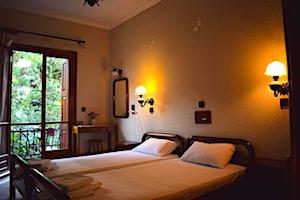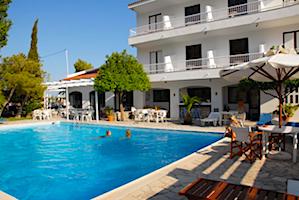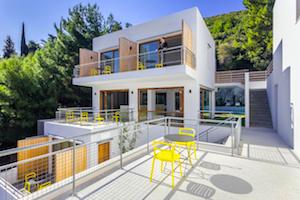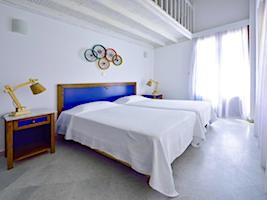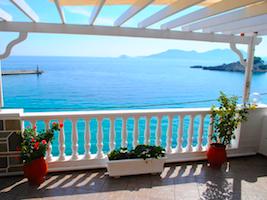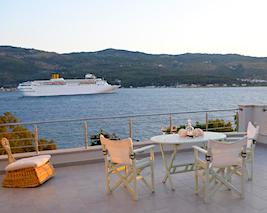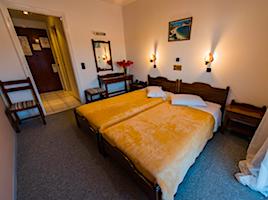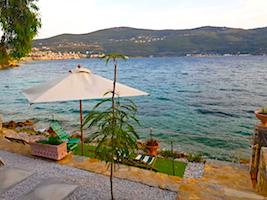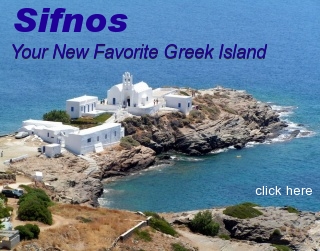
Greek Islands
Samos
Samos
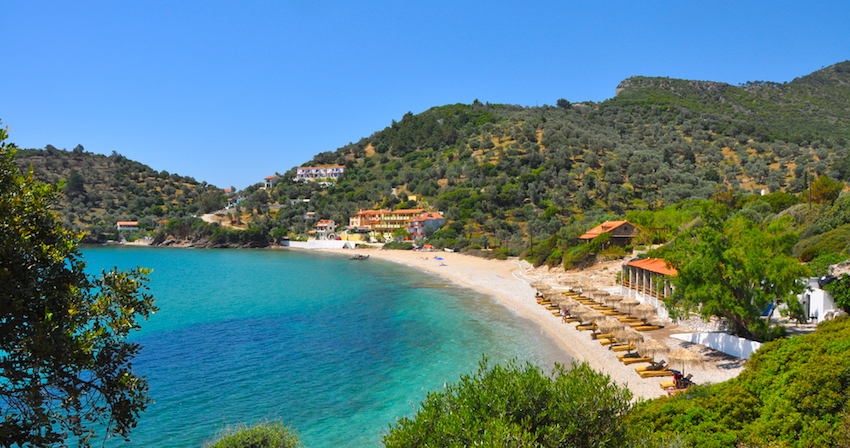
|
By Marc Dubin I fell for Samos on my second-ever trip to Greece, just before the advent of charter tourism and while the island was still merely a stage on the Hippie Trail to Asia. The freaks used to camp at Tzamadoú beach, when its spring still ran freely, their first or last stop in Europe before or after the boat to Turkey. That unbelievably turquoise sea made a counterpoint to hillsides shaggy with Calabrian and black pines. Some 30 villages with gaily painted wooden shutters and tile roofs peaked out of the greenery, linked by a network of cobbled trails across the lush stream valleys.
But even after those infernos, Samos remains one of the greener Aegean islands, thanks both to the climate (on the damp side – 80cm of rain in a good year) and the relatively rich soil; old-timers say it’s the kind of place where any stick you put in the ground sprouts. On the southern slopes it’s true that the terrain is still pretty lunar in spots – there’s been no systematic reafforestation – but on north-facing hillsides young new trees are already the size of a teenager. Given the scenery and colour spectrum painters have always flocked here, and some world-class artists are still resident full- or part-time. There’s a fairly decent music scene too – old rebétika performers Odysseas Moskhonas and Kostas Roukounas were from here, as is the more recent performer Manolis Pappos – and in winter there are plenty of musical tavernas. Samos is at the tail-end of the migratory seafood trail southeast out of the Dardanelles, which means plenty of fishy things to eat – and the local ouzo runs a good second to Lesvos labels. |
||||||||||||
|
|
||||||||||||
|
Vathy is very much the county town and, lacking any spctacular beaches, an unlikely resort – most hotels which opened in the 1980s boom years have closed down or become apartments. One of King Otto’s Bavarian architects advised the Samians in the 1840s to arrange their drainage in a grid plan, not radially to a single outfall which would be vulnerable to prevailing winds and currents. No prizes for guessing what the locals did – so when the wind is from the south, the quayside stinks. Some of the older neighbourhoods with their fine Neoclassical mansions clambering up the steep flanks of the bay remind me a bit of Syros, at a stretch. The 18th-century hillside suburb of Áno Vathy is worth the hike up for its dwindling number of old houses, and an excellent place for refreshment at Pigadáki junction, Albanian-run Paradosiako Kafeneio O Khristos, the only place up here open for lunch, with a limited menu executed on a two-burner stove, and a full tipple list. There’s no real reason to stay in lower Vathý unless you’re on the morning boat to Turkey, but the one must is the Archeological Museum, with most of the finds from the Heraion archeological site spread over two wings: the small objects collection, with unbeatable Archaic art such as the famous griffin heads for adorning cauldrons, and the statue gallery, its star exhibit a huge kouros, the tallest ever unearthed, nearly complete with his Archaic smile. For lunch or dinner, head for the quay, where Zen (shut Sun) serves up a mix of reasonably priced and well-executed meat and seafood. |
||||||||||||
|
|
||||||||||||
|
Kokkari is the first substantial spot west of Vathy, and the island’s second busiest resort. Even though I don’t think I’d ever stay here again, I have a sentimental attachment to it as the first place I ended up on Samos back in 1980 – in an old house overlooking the fishing-port bay, closed off by one of two mirror-image headlands. Despite changes over the four decades since, it’s still stereotypically postcard-perfect seen from the right angle, and has always been windy (a windsurf school off the wildly misnamed, westerly Ammos (“Sand") pebble beach takes full advantage). For a romantic waterside meal Tarsanas out behind the north end of Ámmos has been there since the 1970s, with a choice of seafood, sadly contemporary prices, traditional pizzas, a magirefta of the day and bulk wine that’s great or lousy depending on the year. |
||||||||||||
|
|
||||||||||||
|
The west beach sea is usually too rough unless you’re a boogie- board-surfer – most people head for Lemonákia and Tsamadoú, where headlands nicely break the swell on all but the most boisterous meltémi days. I prefer Tsamadoú because the pebbles are better-shaped, the snorkelling is rewarding, and there’s an established naturist section to the right – also the island’s biggest gay hangout – that catches late afternoon sun. |
||||||||||||
|
|
||||||||||||
|
Tiny Avlákia, just around the corner, is built with its toes in the water and for me is the best spot for a waterside meal on the north coast. There are two tavernas: traditional Delfini (aka Kyria Alexandra’s), with big portions of fish and horta, and Kosmos at the far end, where Tassos (from Kalambáka on the mainland) sevres more polished fare, exceptionally good bread and bulk wine from Thessaly, and not a table to be had on a summer full-moon evening without reservations (tel 2730 94475). Avlákia provides meltémi-sheltered swimming though no beach facilities aside from a shower and a few sunbeds in front of the tiny hotel next to Kosmos. At the far end of Avlakia a steep path leads down from a road curve to a secluded nudie cove, next to bigger, vehicle-access Tzaboú. Both are very scenic with clean water offshore, but I don’t like the degree to which the Tzaboú snack bar controls all access to the beach (which by law is public from the winter tide-mark down) and locks the car park at dusk. Don’t bother showing up during the meltémi – it’s the most exposed beach on the island. |
||||||||||||
|
|
||||||||||||
|
Just inland, the lush valleys around and below the popular villages of Vourliotes, Manolates and Ámbelos escaped major fire damage so walking there is still rewarding. After long neglect and destruction, the area’s trail network has been minimally cleared and signposted, so you can (for example) walk up from Kokkari to Vourliotes, continue to Manolates, then descend to Ágios Konstantínos and a bus back to base. Or leave a scooter in Vourliotes and do a 3-hour loop walk from there to Manolates, Aïdonia valley and back to Vourliotes. These are “balcony” villages – the view north over the straits to Turkey on a clear day is unmissable. Vourliotes with vineyards all around was always the biggest and most important. Some years ago greedy restauranteurs in the central plateía convinced the municipality to cut down two mulberry trees that gave wonderful shade, just so they could squeeze in more tables, so I don’t go there anymore. Instead I patronize to Galazio Pigadi, a few steps beyond the platía (most reliably open for dinner). |
||||||||||||
|
|
||||||||||||
|
Manolates is a bit higher, more deep-country, and has the best apples in Samos if not Greece (including the Pílion). If you’re there for the mid-October apple festival, buy as many as you can carry. There are unusually arty souvenirs for sale, including some excellent (and expensive) raku ware. Manolates has long been an "in" local place to eat, although there are only two surviving central tavernas. Kallisti (aka Magda and Tasos) is the more economical and most down-home (it doubles as the kafeneío) and even during winter (weekends only) you might wait for a table. Despina’s, under the gazebo by the fountain up the hill, is culinarily less accomplished and only works during tourist season. Ámbelos seems set to take a dive into the Aegean far below, that’s how precipitous the setting is. It was pretty much the first hill village to attract foreigners, with some artists still in residence. It’s also notorious as the epicentre of local Jehovah’s Witnesses – for unknown reasons Sámos has hundreds of them. |
||||||||||||
|
Back on the coast, below Manolates and Ámbelos, is Ágios Konstantínos, which most people like despite there being only a rudimentary beach at the east end of the coastal esplanade. The old honey-toned stone houses straggle along the coast road for some distance until the little fishing port, past the best surviving restaurant: Kyma, with a mix of mezédes, main dishes (including magireftá) pitched affordably, and a minor notoriety for hosting Bill Clinton on his late 2000 visit to Greece. Ask to see the newspaper clipping commemorating his meal here. Heading west, some major, EU-funded engineering has straightened out the kinks in the old coastal corniche route before you pass the side road up to the tongue-twistingly named village of Kondakéïka and, signposted a couple dirt-track kilometers beyond, the church of Kímisis Theotókou at Petaloúda. Sámos has lots of these remote shrines but this contains the best Byzantine frescoes, from the late twelfth century. Outside it looks unassuming, like country chapels I’ve seen in western Crete, but inside (always open) it’s glorious. You’ll probably have it to yourself except at the August 15 festival. |
||||||||||||
|
|
||||||||||||
|
Return to the main highway and you’re on the outskirts of Karlóvassi, Samos’ other north-coast port. It’s actually marginally bigger than Vathy, and has the maths/computer science faculty of the University of the Aegean, but is still officially the island’s second town. Karlóvassi, unlike Vathy, sits on a plain and has room to spread out. There are some grand, mostly well kept mansions dotted around under palm trees, funded by the now-vanished leather industry based in the warehouses and tanneries of coastal Ríva neighbourhood – the industrial effluent into the sea was so acidic that careless swimmers could get all their hair burned off. The last tannery closed in 1972 but a very good museum of the industry (Mon–Fri 8.30am–2pm) has opened near the westerly river-mouth, inside a small former tannery. Most of these typically vast buildings still survive, underutilized except for a few marble workshops and auto mechanics’. Communist poet Yiannis Ritsos was exiled here by the junta (his wife was a Karlovassian) and the street where he lived under house arrest is named for him. Central (Meséo) Karlovassi is pleasant and old-fashioned, with a big square (tavernas mainly active at night) and hillside houses overhead; at lunchtime, try Alatopipero, on the shopping street from Néo Karlovassi square down to the bus station and university HQ. There are a few more in older Meséo Karlóvassi, around the little plateia. Dionysos, for special occasions, has Athenian pretensions in cooking and wine list; there are more affordable, tasty options just opposite. But if you’re visiting, you’ll most probably end up in Limín Karlóvassi, where all main-line ferries (and local services to Foúrni) dock. Most hotels are here, but no really recommendable spots for lunch before a late-afternoon boat out. |
||||||||||||
|
|
||||||||||||
|
On warm afternoons most of Karlovassi goes 4km west to Potami beach, not four-star but certainly convenient. The river of the name starts inland in a steep-sided canyon with Samos’ oldest church, 10th-century Metamorfosis, a proper castle overhead – full of crocuses in mid-October – and, a 100 yards’ wade through chilly water, an impressive waterfall. It’s no longer exactly secret, and has been equipped with an abseiling rope and a steep stair-path to get you to the top of the cascade. Mind where you step in the stream – some years there are little nippy fresh-water crabs, or even eels brought here by a sea-surge and then trapped. Just behind Potámi beach, Hippy's usually has a creative, full midday menu and free sunbeds for a nap (or even a swim if the wind is down). |
||||||||||||
|
|
||||||||||||
|
The best surviving (mostly) trail walk on Samos is from Potámi to Dhrakéï. If you’ve got a car or a scooter, drive west of Potámi on the wide track for about 2km until you see the true trailhead – if the wood sign is down there’s usually a marker cairn. In under half an hour you’ll be at Mikró Seïtáni, an idyllic little pebble cove with no dress code. If it’s full up, keep on another half hour through the half-tended olive groves to giant, sandy Megálo Seïtáni, at the mouth of the Kakopérato ravine, with Kerkís mountain soaring overhead. Again you should be able to skinny-dip except when the illegal cottages at the far end of the bay are occupied. They’re illegal because the entire coast here is a protected reserve for the sake of the handful of Mediterranean monk seals who still live nearby. One drizzly May afternoon in 2007 I was lucky to spot two young ones swimming along the coast between Megálo and Mikró. I didn’t have my camera on me and by the time my ladyfriend fished hers out they didn’t show up too well from high up on the path where we were, so you’ll just have to believe me. Beyond Seïtáni the trail climbs manageably to Dhrakéï, an absolutely back-of-beyond village looking across to Ikaría. There are two or three vociferously competing snack bar/tavernas here to have lunch at before starting back to Potámi (and ideally another swim en route). |
||||||||||||
|
If you drive south from Karlovassi instead of west you’ll pass below Plátanos, famous for its name-checking in the folk song that’s the island’s real “national anthem” (never mind “Samiotissa”): As iha nero ap’to Platano If only I had water from Platanos, The water, renowned as the best on Samos, gushes in abundance from a cave-alcove on the little square with its huge plane trees. As with other places in Greece with much-praised springs, a legend says that if you drink you’ll be guaranteed to return here. Leon is the worthwhile surviving taverna on this square. |
||||||||||||
|
|
||||||||||||
|
Near Plátanos, there’s a fork in the road system; dropping southwest takes you to Órmos Marathákambos, the third of Samos’ four ports. It’s a dozy place with lots of accommodation and wooden boats being built on the shore, though potentially less dozy now that a yacht marina has been dredged and inaugurated. But most people are staying a bit west at Votsalákia ("Little Pebbles"), a long strung-out resort with a long straggly, mostly sand beach and all the usual amenities. The best thing to do here is climb Mt Kerkís, which you can’t miss. The classic route goes via the convent of Evangelistrías, just beyond where the farm track ends the proper path begins. Don’t try it in high summer – you’ll be baked on the south-facing slopes – though there is a spring near the top and a small hut for emergency shelter. Just below the summit occurred one of old Olympic Air’s worst disasters – on August 3, 1989 a flight from Thessaloniki clipped the ridge in heavy mist and disintegrated with the loss of all on board. They say you can still spot bits of wreckage and scattered luggage but I’ve been twice since and never noticed any. The gnarlier route up starts from above Kallithéa village, clockwise around the mountain, but it’s less obvious – get local instructions. |
||||||||||||
|
|
||||||||||||
|
Beyond Votsalákia is what has to be, in a way, Samos’ most ridiculous beach – Psilí Ámmos (West). Wade out 300 yards and you’ll still be only knee-deep. Great for kids, very sandy, very scenic. Just east, at the western end of Votsalákia, is more normally shelving Fournáki with its pebbles always stacked artistically by beachcombers. Overhead is one of the best magirefta tavernas on the island, Loukoullos – better in the evening when all the dishes are done cooking. They only normally open June to early September, as both proprietors have other jobs as lawyers in Vathy. |
||||||||||||
|
From the main loop road contouring southeast beyond Platanos, various turnoffs drop to the coast. The best is for Bállos, a long pebble beach ending in a sandier cove with caves in back to shelter in: one of the quietest corners of Samos. On the way back up, have a coffee or lunch (Tavarna Sama) on the square of Kouméïka, with the most beautiful carved-marble fountain on the island. Back on the loop road, there are some honey-and-herb stalls; I like Farm Store, just before Koútsi oasis – I’ve been assured he doesn’t adulterate his honey. |
||||||||||||
|
|
||||||||||||
|
From the “pottery village” of Koumaradéï, with lots of typical, self-emptying koúpes tou Pythagóra (Pythagora cups) on sale, there’s an eyeful of the great sweep of bay fringing Pythagorio, the airport runway, and the Heraion, Samos’ ancient Hera sanctuary – though there ain’t much left standing, just a single column that medieval masonry thieves kept intact as a navigation aid. Still, the precinct – especially the exposed Sacred Way pavement – is impressive. Modern Iréon village just next door, with a direct road down from Koumaradéï, started out as a fishermen’s hamlet – you can still see their original wonky cottages on the water’s edge – but is now a busy, friendly if rather non-descript grid-plan resort which because it faces east is a prime place to watch moonrise over the sea – summer nights around the full moon, you won’t get a seaside taverna table for love or money. My favourite spot, especially for lunch straight off the plane, is O Glaros, which works most of the year (reserve summer dinners on 22730 95457. The family is originally from Agathonísi, just on the horizon; Mama cooks up a storm (especially dolmádes) while son Telis mans the grill. The food’s cheapish and very abundant – go hungry, portions feed two. For something a bit more elegant and pricier, try seafood-strong Cohyli just up the road and a block inland – Christina speaks perfect English (after years in London) and does delicate things with her brother’s catch of the day. No sea view, but lovely courtyard seating. Reserve dinner in season on 22730 95600. |
||||||||||||
|
|
||||||||||||
|
Pythagório, across the fertile plain around the airport, was the first Samian resort to be developed. It covers the ancient city built by the Archaic tyrant Polykrates – archeological bits poke up here and there, including a Byzantine basilica by the castle (really a 19th-century fortified manor, which has become a free museum (erratic hours). The harbour is still as good as it was in years BC, full of excursion kaïkia and (though most have been banished to a purpose-built marina around the corner) a few yachts. If you’re coming from the northern Dodecanese by caamaran or the milk-run ferry Nisos Kalymnos, this is where you’ll dock. Accommodation touts meet all arrivals and you may as well follow them to see what they have – often remarkably affordable (if basic). The inner quay is solid with café bars and not much else, aside from the seafood ouzeri Mouragio (Mar–Nov); most restaurants are tucked away inland, most notably To Tigani tis Plateias on the shady inland square opposite the old town hall. Reserve a table for supper here in season on 22731 04500. |
||||||||||||
|
Pythagório has its very own, accomplished resident rebétika musician, Ioannis Loulourgas. In summer he’s got a souvenir and musical-instrument shop in the backstreets where you can buy some of his own produced CDs (the rebétika ones, not the ‘tourist soundtrack’ ones). |
||||||||||||
|
|
||||||||||||
|
Pythagorio has an archeological museum nearly as good as Vathy’s. Although completed at great expense (and its exhibits prepared) in 2005, owing to one of those Greek politico-bureaucratic mysteries, it only opened in early 2010. Along with the usual pottery from all eras and grave finds, there’s a monumental statue of Emperor Trajan on the top floor, and a hoard of 300 Byzantine gold coins found in a brass jug by a Dutch archeologist in 1983 at a remote nearby bay. Also viewable out back, from elevated walkways, are extensive stretches of floor mosaics from villas of the Roman town; ask staff if you can't find the way there, it's not well signposted. |
||||||||||||
|
Be sure to also visit the restored Evpalinian Aqueduct on the hillside above modern Pythagorion, designed in the 6th century BC by the great architect and civil engineer Eupalinos of Megara, and built by slave labor mustered by local tyrant Polykrates. The 1036-metre-long aqueduct is one of the finest achievements of ancient civil engineering, described by the Greek historian Herodotus as the 8th wonder of the ancient world, but not for the claustrophobic. You have to book an escorted tour – mandatory protective helmet provided, even midgets will bang their heads on the ceiling – the day before on 22730 62813 except at very slow times, when you can chance just showing up. Choose between a super-brief visit, or most popularly about a third of the way through to the point where the work-crews, tunnelling from opposite sides of the mountain, met up with a scant horizonal error, or the full length traverse (arrange a taxi back from the far end). You follow the rock-hewn catwalk that perches high above the actual channel, where water still trickles along. |
||||||||||||
|
|
||||||||||||
|
Heading back to Vathy, detour east to the Straits of Mykale, about 1400m wide, one of the narrowest distances between a Greek island and Turkey, which here means hulking Mt Mykale. There’s a prominent Turkish islet (Bayrak, formerly Ágios Nikólaos) in the middle, with a lighthouse on it, plus a salt marsh – the Alykí – just inland where from December to May there can be as many as 250 flamingoes resident, arrived from East Africa. Around the corner is sandy Psilí Ámmos (East) cove, with good swimming, especially for small kids. I like Psili Ammos taverna, on the right, which has good seafood and a long season (until 28 October). But I prefer swimming at pebbly Mykáli beach, in front of the excellent Aperanto ("Endless") Taverna, with superior fare to Psili Ammos – especially seafood – and free sunbeds plus a shower for customers. |
||||||||||||
A Trip to Turkey |
||||||||||||
|
|
||||||||||||
|
Speaking of Turkey, hopping over to visit the sprawling ruins of Ephesus is the most popular day-trip from Samos (after going to Pátmos, that is) In peak season there are daily departures daily from either Vathy or Pythagório to the Turkish port of Kușadası, at about 8.30am and 6pm (though the latter means overnighting in Turkey plus mandatory visa purchase, online in advance only). Boats run reliably from just after Easter until about October 20. The journey takes 90 minutes each way, assuming calm seas; in shoulder season, you can get fares of 35–40 euros round trip (plus 10 euros baksheesh aka ‘port tax’, collected at the passenger terminal at Kusadasi) – in peak season this can easily exceed 50 euros. Day-trippers do not currently need a Turkish tourist visa; in recent years, the Pythagório services have been more reliable. Kuşadası (Bird Island) is a brash funfair of a resort that keeps reinventing itself to appeal to the tackier end of the mass tourist market. (“Kusadasi is for the Birds” has always been my favourite promo slogan to recommend to the lo cal tourism board. Well, on second thought, maybe not…). Years ago it was Irish come to drink in the self-billed “Bar Lane”, now it seems to be Bulgarians and Romanians after shoddy carpets and cheap leather jackets. The hustle starts directly you step out of the massive duty free mall on the quay into a gaggle of taxi drivers (“Hello my friend, where you going…”). If you don’t arrive on a tour, you may well find yourself dealing with them to get the maximum out of a short (5-hour-ish) stay in Turkey. Besides a stop at the taxi-driver’s cousin’s shoddy carpet farm or cheap leather jacket shop, ancient Ephesus will obviously be tops on your list. It’s a vast site needing at least 2.5 hours to see properly; highlights are the façade of the Celsus (Kelsos) library, the so-called ‘terrace houses’ (exra admission fee) with their fine floor mosaics, the Hadrian shrine, the theatre (still used for culture festivals), and what’s titillatingly indicated as a Roman ho’house, complete with footprint-petroglyph as a hieroglyphic for those in the know. The fact that the Austrian excavators have treated the place more as a civil engineering project, with concrete rebuilding everywhere – than an archeological dig detracts only slightly from the experience. If you’ve time for lunch in Kuşadası before the boat back, check out either Avlu, 1 block inland on Cephane Sokak 15, or its near-neighbour Öz Urfa at no. 9, two locally patronized tavernas with honest stews and grills (though beer only at the second establishment). More on Kusadasi/Ephesus |
||||||||||||
A TRIP TO FOURNI |
||||||||||||
|
|
||||||||||||
|
When I need an antidote to Samos, nearby, laid-back Foúrni is perfect. It’s tricky as a day-trip – the catamaran from Pythagório calls perhaps 3 days weekly in season – but just a quick afternoon journey from Karlóvassi, which means an overnight on the islet. Foúrni is all of one, surprisingly large harbour town with a mulberry-shaded, flagstone-paved agora street and a garland of tiny beaches around the arid island’s perimeter, mostly in the south half – my picks are Áspa and Kasídi, both sandy rather than pebbly and both naturist. There are plenty of places to stay in town, but waterfront tavernas have declined in value – eat inland around the main plaza, at Kali Kardia, or by taxi ride to Almyra behind remote Kamári beach (best confirm their opening and a table on 6979 141653). |
||||||||||||
|
|
||||||||||||
Samian WinePraised by Lord Byron in his Poem "The Isles of Greece", the local wine has had many (mis)adventures since his time. Of late, relief from the dead hand of the local vintners' co-op has come from at least two private winemakers and another, smaller co-op in Plátanos village. Domaine Vakakis (www.vakakiswines.gr) near Karlóvassi produces quality white and rosé, and their winery hosts tours; Hatziioannis (no tours), outside of Mytilinií village, makes a superb, velvety, rather pricy red (Granatis, "Garnet"). Plátanos vinters feature Mandilariá rosé, low alcohol and slightly sweet because it includes moskháto (muscat) white grapes as well as mandilariá red. |
||||||||||||
|
About Marc Dubin Marc Dubin first visited Greece in 1978, fell in love with it, and returned almost yearly until he began living much of the time on Samos in 1989. He has written for numerous travel publishers – notably Rough Guides and Insight Guides – and on a variety of topics ranging from renovating old Greek houses and Greek cuisine to back-country trekking and Greek music. Marc has also compiled two CDs for World Music Network, Rough Guide to Rebetika and Rough Guide to Greek Café. He is an accomplished photographer and many of the pictures accompanying the articles on greecetravel.com are his. To contact Marc with offers of writing jobs or praise you can e-mail him through matt@greecetravel.com |
||||||||||||
|
|
||||||||||||
Practical Information for Samos
|
||||||||||||
|
GETTING TO AND AROUND SÁMOS Samos is still a local sea-transport hub, though less important than before; besides at least 3 weekly services from Piraeus, Ikaría, Foúrni and Syros, the local Nissos Kalymnos ferry goes to and from the Dodecanese; there is talk of the Dodekanisos Pride or Dodekanisos Express catamaran extending its run from Pátmos to Sámos in summer 2014, to replace the vanished hydrofoils, but we have heard this talk since 2012 with nothing to show for it. There are also 2 to 3 weekly ágones grammés boats calling from northern Greece, usually Kavála, via intermediate islands. There are several daily flights from Athens, though rarely enough seats in summer when prices rocket. A notionally useful air route on Sky Express, with subsidized prices, also links Samos with Rhodes, Híos and Lésvos two days weekly, but it’s not very practical for holiday-makers – there is effectively NO carry-on allowance (a purse or a laptop at most) and a strictly enforced 15-kilo limit for checked luggage, versus 20 to 23 for ‘real’ airlines plus a proper carry-on. Once on the island, there are swarms of scooters and cars to rent (the latter on the pricey side unless pre-reserved), and usually enough taxis to go around. If you fly in, it’s more cost-effective to pick up a car from the get-go at the airport – a return taxi-trip to Kokkari (one of the main resorts) will set you back almost the same as two days’ rental. For those who plan to combine Samos with other islands and Athens your best bet would be to work with one of the travel agencies in Athens who book hotels and ferries and can keep your plans intact. Agencies that work with Samos may not even mention it on their websites but you can still contact them and they will be happy to book it for you after first trying to convince you to go to Mykonos or Santorini instead. See www.athensguide.com/agency.html |
||||||||||||
|
|
||||||||||||
HOTELS IN SAMOS |
||||||||||||
|
Below are a few hotels in Samos with links for more information and booking. You can also find lots more hotels at Matt's Hotels of Greece Samos Page |
||||||||||||
|
Ino Village Hotel Located in the Kalami area of Samos Town, Ino Village Hotel is considered the best hotel for the money on Samos and offers a swimming pool and restaurant, only 450 metres from the famous Gangou Beach. It features elegant, air-conditioned rooms with balcony. The stylish rooms at the Ino Village feature calming colours and provide guests with minibar, hairdryer, and free Mastic Spa toiletries. Some rooms have sea or pool view. The bar is open all day and serves coffee and light lunches. Elea restaurant serves traditional and contemporary Greek specialties on the vine-covered veranda with views over Samos Town Bay. Guests can relax in the courtyard that features high quality teak sun loungers. Free Wi-Fi access is possible in communal areas. Samos Port with shops, traditional Greek taverns and bars is 900 metres away. Staff can arrange car rental and free private parking is offered on site. For Information, Photos and Booking this Hotel Click Here |
||||||||||||
|
Hotel Anema by-the-Sea Located between sea and mountain in the town of Karlovassi, the Hotel Anema by-the-Sea offers a relaxing and pleasurable atmosphere all year round. They are a family owned and operated small enterprise dedicated to providing friendly & comfortable accomodations. Owned by two Greek-Canadians, Diamantis Foustanellas and his Ottawa-born wife Toula the studios and apartments are quaintly furnished retaining the island style while the kitchenette is equipped with cookware suitable for light meals. For Information, Photos and Booking this Hotel Click Here |
||||||||||||
|
Doryssa Seaside Resort Situated in the southern part of Samos, next to the popular historical destination of Pythagorion, this superb 5-star resort offers a breathtaking view of the Aegean Sea. Doryssa Seaside Resort lies on a long sandy beach that is protected from the wind. A magnificent setting is the result of unique architecture. Environmentally friendly materials, energy saving policies and upholstery made of pure linen create a clean and refreshing ambience for your stay. Special materials have been used in all the rooms in Doryssa Seaside Resort to make your stay as comfortable as possible. For Information, Photos and Booking this Hotel Click Here |
||||||||||||
|
Proteas Blu Resort Hotel The 40.000 square metres complex that is Proteas Blu Resort Hotel, overlooking a sheltered cove with two naturally secluded beaches, is located in Pythagorion. The luxurious Proteas Bay Hotel boasts accommodations looking out to the sea. Each unit, combining traditional style with contemporary design, offers air-conditioned rooms with king-size beds. Proteas Bay Hotel offers a wide range of deluxe services and facilities including a pool complex and complimentary shuttle service. For Information, Photos and Booking this Hotel Click Here |
||||||||||||
|
Arion Hotel Located on the North Coast of Samos, near the village of Kokkari, the 4-star Arion Hotel is surrounded by a broad expanse of green lawn. The traditional-style, fully-air conditioned rooms are spread throughout one main building and a complex of bungalows. The comfortable rooms are equipped with all modern amenities, including large verandas overlooking the sea. It is only 600 metres from the 2 most popular beaches of Samos Island, Tsamadou and Lemonakia. The sparkling waters are ideal for all kinds of sports. The restaurant specialises in Greek cuisine with daily international dishes. Once a week in June, July and August, our Greek evenings are always popular, with a sumptuous buffet, Greek music and folk dancing. For Information, Photos and Booking this Hotel Click Here |
||||||||||||
|
Hotel Glicorisa Beach Within 3 km of Pythagorion town in Samos, the quiet, family-run 3-star Hotel Glicorisa Beach is 10 km from the airport and 15 minutes from the main port town of Samos. Established in 1980 and renovated in 2001, the hotel is built amphitheatrically on a hill, overlooking the Turkish coasts and the natural Glicorisa Bay. There is a private beach right next to the pine trees. On the restaurant’s large veranda, the family and staff serve your breakfast or dinner as a buffet that covers all tastes. The beach bar serves all kinds of drinks, beverages, ice creams and snacks. In the hotel lounge, you can also find the old fashioned Greek bar with its local wood decoration. For Information, Photos and Booking this Hotel Click Here |
||||||||||||
|
Samaina Hotel Situated in a quiet area of the lively coastal village of Pythagorion, the 2-star Samaina Hotel is a charming building constructed in traditional Greek architecture, surrounded by a lovely rose garden. The 21 rooms of the hotel have either a balcony or a roof terrace with a view, with most rooms enjoying sea view. Each room features bathroom with shower, refrigerator, ceiling fan or air condition. Samaina Hotel offers tour desk and car rental services and may facilitate in any need for recommendation or advice about Pythagorion or the surrounding areas. For Information, Photos and Booking this Hotel Click Here More Recommended Hotels on Samos |
||||||||||||
|
||||||||||||
|
For more hotels visit Matt's Hotels of Greece Samos Page For more on Samos see Toula Foustanalla's Introduction to Samos |
 Use Ferryhopper to find all direct and indirect ferry routes for the islands of Greece, Spain, Italy &
Turkey, compare ferry companies & prices, and book cheap ferry tickets with no hidden fees in one go!
Use Ferryhopper to find all direct and indirect ferry routes for the islands of Greece, Spain, Italy &
Turkey, compare ferry companies & prices, and book cheap ferry tickets with no hidden fees in one go!
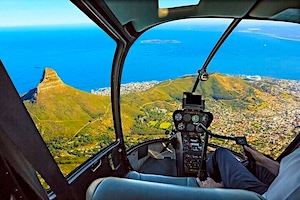 Travel to the Islands by Helicopter!
Travel to the Islands by Helicopter!
Return to Matt's Greek Islands Guide
Join Matt Barrett's Greece Travel Guides Group on Facebook for comments, photos and other fun stuff. If you enjoy this website please share it with your friends on Facebook. If you are appreciative of all the free information you get on my websites you can send a donation through Paypal Or you can use Venmo at venmo.com/Matt-Barrett-Greece
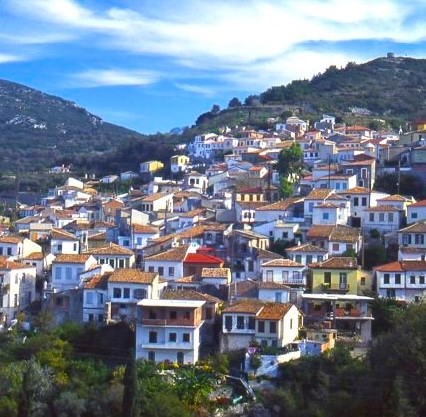 That beach is regimented now, most paths are bulldozed, and as in many spots around Greece the village houses are defaced with horrible flanged tiles or aluminium shutters and doors. The hippies have yielded to a relatively sedate tourism scene, and Samos got some extra bad PR in summer 2000 with a mammoth, week-long fire which burnt nearly
half the forest; there have been a few more blazes since.
That beach is regimented now, most paths are bulldozed, and as in many spots around Greece the village houses are defaced with horrible flanged tiles or aluminium shutters and doors. The hippies have yielded to a relatively sedate tourism scene, and Samos got some extra bad PR in summer 2000 with a mammoth, week-long fire which burnt nearly
half the forest; there have been a few more blazes since.